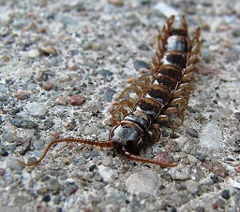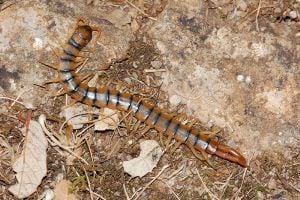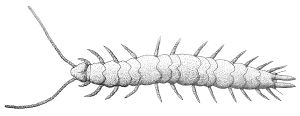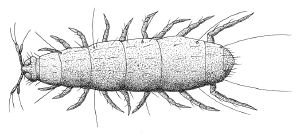Myriapoda
| Myriapoda
| ||||||
|---|---|---|---|---|---|---|
 Lithobius forficatus, a centipede
| ||||||
| Scientific classification | ||||||
| ||||||
|
Chilopoda |
Myriapoda is a subphylum of terrestrial arthropods, characterized by an elongated body with many segments, typically many legs with a pair for every segment or double somite, a single pair of antennae, and simple eyes. The name myriapoda suggests these invertebrates have myriad (10,000) legs, but they range from less than ten legs to up to 750 legs. Prominent members include the centipedes, comprising the class Chilopoda, and millipedes, comprising the class Diplopoda. Two other extant classes are Pauropoda and Symphyla. Millipedes differ from the other groups in having their body segments fused into pairs, giving the appearance that each segment bears two pairs of legs, while the other three groups have a single pair of legs on each body segment.
role in food chains. Centipedes primarily Centipedes are typically fast-moving, predatory, terrestrial arthropods that feed on insects (such as flies and cockroaches) and other invertebrates, and even small vertebrates. consuming actual household pests like bedbugs, termites, cockroaches, and so forth.
Millipedes primarily
wonder of nature 2 meter long
Known from a long time ago class Arthropleuridea extinct
Scientists who study centipedes are called myriapodologists.
Overview and description
As arthropods, myriapods have a segmented body, paired, jointed appendages on most segments, and are covered by a hard exoskeleton, made out of protein and a tough polysaccharide called chitin. This exoskeleton must periodically be shed when the myriapod grows and molts.
There are about 13,000 species in Myriapoda, all of which are terrestrial (Waggoner 1996). They are characterized by one pair of antennae, a single pair of mandibles, primitive eyes (ocelli), and many segments, which are not fused together. Their appendanges have only one ramus, or branch (Waggoner 1996). Extant myriapods range in size from nearly microscopic to 30 centimeters in length, but an extinct form from the Carboniferous, placed in the extinct class Arthropleurida, was giant in size, reaching up to two meters in length.
Myriapods range from having over 750 legs (Illacme plenipes) (Marek and Bond 2006; BBC 2006), the world's leggiest animal, to having fewer than ten legs (Waggoner 1996). Growth is by adding segments and legs with successive molts (anamorphic), and myripods continue to add additional segments and legs after they have reached sexual maturity (BBC 2006; Paleos).
Although not generally considered dangerous to humans, many myriapods produce noxious secretions (often containing benzoquinones) which can cause temporary blistering and discoloration of the skin (Arment).
The majority of myriapods are herbivorous, with the notable exception of the over 2,500 species of centipedes (Myers 2001), which are chiefly nocturnal predators. Pauropodans and symphylans are small, sometimes microscopic animals that resemble centipedes superficially and live in soils.
Myriapods are abundant in moist forests, where they fulfill an important role in breaking down decaying plant material (Waggoner 1996), although some live in grasslands, semi-arid habitats, or even deserts, as well as human dwellings.
Evolution and phylogeny
The fossil record of myriapods reaches back into the late Silurian, although molecular evidence suggests a diversification in the Cambrian Period (Friedrich and Tautz 2002), and Cambrian fossils exist which resemble myriapods (Waggoner 1996).
There has been much debate as to which arthropod group is most closely related to the Myriapoda. Under the Mandibulata hypothesis, Myriapoda is the sister taxon to Pancrustacea, a group comprising the Crustacea and Hexapoda. Under the Atelocerata hypothesis, Hexapoda is the closest, whereas under the Paradoxopoda hypothesis, Chelicerata is the closest. This last hypothesis, although supported by few, if any, morphological characters, is supported by a number of molecular studies (Hassanin 2006).
Classification
There are four classes of extant myriapods, Chilopoda (centipedes), Diplopoda, Pauropoda and Symphyla, containing a total of around 12,000 species [2]. While each of these groups of myriapods is believed to be monophyletic, relationships among them are less certain [3].
Centipedes
Centipede ("hundred legs") is the common name for any member of the arthropod class Chilopoda, comprising species with long, flattened bodies with many segments, and with one pair of jointed appendages on each segment except the last two. The appendages on the first segment take on the form of jaw-like, venomous claws with poison glands that are used in capturing prey. The head of a centipede has a pair of jointed antennae. The most anterior trunk segment of a centipede has a pair of venomous claws, called maxillipeds, that are used for both defense and for capturing and paralyzing prey.
Like the millipedes, which they resemble, centipedes are highly segmented (15 to 173 segments). However, millipedes have a cylindrical body with two pairs of legs on most segments, while centipedes are dorso-ventrally flattened and have only one pair of legs on most segments (excepting the hindmost segment).
Despite their common name, which stems from the Latin words centum (meaning "hundred") and pes, pedis (meaning "foot"), they normally have around half that number of legs, though it is possible to find centipedes with over 200 legs.
Millipedes
Most millipedes are slower than centipedes, and feed on leaf litter and detritus. They are distinguished by the fusion of each pair of body segments into a single unit, giving the appearance of having two pairs of legs per segment. Around 8,000 species have been described, which may represent less than a tenth of the true global millipede diversity [2]. One species, Illacme plenipes has the greatest number of legs of any animal, with 750 [4]. Pill millipedes are much shorter, and are capable of rolling up into a ball, like pillbugs.
Symphyla
About 200 species of symphylans are known worldwide [2]. They resemble centipedes but are smaller and translucent. Many spend their lives as soil infauna, but some live arboreally. Juveniles have six pairs of legs, but, over a lifetime of several years, add an additional pair at each moult so that the adult instar has twelve pairs of legs [5].
Pauropoda
Pauropoda is another small group of small myriapods. They are typically 0.5–2.0 mm long and live in the soil on all continents except Antarctica [6]. Over 700 species have been described [2]. They are believed to be the sister group to millipedes, and have the dorsal tergites fused across pairs of segments, similar to the more complete fusion of segments seen in millipedes [7].
Arthropleuridea
Arthropleurids were ancient Myriapods that are now extinct. The most famous members are from the genus Arthropleura, which was a giant, probably herbivorous, animal that could be up to 3 meters (about ten feet) long. The Arthropleurids may be a division of the millipedes.
ReferencesISBN links support NWE through referral fees
Chad Arment Herper.com [8].
- BBC. 2006. Most leggy millipede rediscovered. BBC News. Retrieved April 1, 2007.
[9].
- Integrated Taxonomic Information System (ITIS). 1999. Myriapoda ITIS Taxonomic Serial No.: 563885. Retrieved June 1, 2008.
Myers, P., R. Espinosa, C. S. Parr, T. Jones, G. S. Hammond, and T. A. Dewey. 2008. Myriapoda. The Animal Diversity Web (online). Accessed January 13, 2009 at http://animaldiversity.org.
- Myers, P. 2001. Chilopoda. Animal Diversity Web. Retrieved January 14, 2009.
Palaeos. n.d. Myriapoda.
[10],
Waggoner, B. 1996. Introduction to the Myriapoda. University of California Museum of Paleontology.
- ↑ Myriapoda (TSN 563885). Integrated Taxonomic Information System.
- ↑ 2.0 2.1 2.2 2.3 A. D. Chapman (2005). Numbers of Living Species in Australia and the World. Department of the Environment and Heritage. ISBN 0-642-56850-2.
- ↑ Jerome C. Regiera, Heather M. Wilson & Jeffrey W. Shultz (2005). Phylogenetic analysis of Myriapoda using three nuclear protein-coding genes. Molecular Phylogenetics and Evolution 34: 147–158.
- ↑ 4.0 4.1 Paul E. Marek & Jason E. Bond (2006-06-08). Biodiversity hotspots: rediscovery of the world's leggiest animal. Nature 441: 707.
- ↑ Garden Symphylans. Integrated Pest Management on Peppermint-IPMP3.0. Oregon State University. Retrieved 2007-07-02.
- ↑ Pauropods: Pauropoda. Insects and Spiders Scientific Reference. Retrieved 2007-07-02.
- ↑ David Kendall (2005-06-06). Pauropods & Symphylids. Kendall Bioresearch.
- ↑ Strange and Unusual Millipedes. herper.com. Retrieved 2007-07-02.
- ↑ Alexandre Hassanin (2006). Phylogeny of Arthropoda inferred from mitochondrial sequences: strategies for limiting the misleading effects of multiple changes in pattern and rates of substitution. Molecular Phylogenetics and Evolution 38: 100–116.
- ↑ Markus Friedrich & Diethard Tautz (2002). Ribosomal DNA phylogeny of the major extant arthropod classes and the evolution of myriapods. Nature 376: 165–167.
| |||||||||||||||||
Credits
New World Encyclopedia writers and editors rewrote and completed the Wikipedia article in accordance with New World Encyclopedia standards. This article abides by terms of the Creative Commons CC-by-sa 3.0 License (CC-by-sa), which may be used and disseminated with proper attribution. Credit is due under the terms of this license that can reference both the New World Encyclopedia contributors and the selfless volunteer contributors of the Wikimedia Foundation. To cite this article click here for a list of acceptable citing formats.The history of earlier contributions by wikipedians is accessible to researchers here:
The history of this article since it was imported to New World Encyclopedia:
Note: Some restrictions may apply to use of individual images which are separately licensed.




